Chinese President Xi Jinping visited the city of Ma'anshan in Anhui Province on August 19 where he visited Magang Group of China Baowu Steel Group to learn about the resumption of business operations.

President Xi Jinping learns about the situation of business resumption and operation while visiting a workshop of Magang Group of China Baowu Steel Group in Ma'anshan, East China's Anhui Province, Aug. 19, 2020. (Photo: Xinhua)
When the People’s Republic of China was founded in 1949, steel output in the country was 158,000 tons, less than 1/1,000th of the world's steel production.
Today China's steel output reportedly accounts for half of the world's.
Advanced production
In December 1980, the annual iron output by the medium blast furnace of the Magang Group exceeded 1 million tons.
In 2019, 18.1 million tons of iron, 19.4 million tons of steel and 18.75 million tons of rolled steel were produced at the company which had an operating revenue of 98.6 billion yuan ($14 million).

In 1974, Wuhan Iron and Steel Group successfully produced its first roll of 1.7-meter steel. (File Photo: Wuhan Iron and Steel Group)
September 13, 1958 was a milestone in the history of China with the first melted iron produced by the first blast furnace of Wuhan Iron and Steel Group.

A worker from the Taigang Stainless Steel Precision Strip Company displays a hand-tearable steel strip. (Photo: Xinhua)
In 2018, the research and design team of Shanxi Taigang Stainless Steel Precision Strip Company produced a precision stainless steel strip at a thickness of 0.02 millimeters, which could be torn by hand.
Innovative manufacturing
In the early 1980s, Magang Group speeded up its technical transformation to achieve an annual output of 2 million tons.
Magang made a historical breakthrough with promising economic growth. The growth rate in profits and taxes exceeded that of output value.
Magang resolved excess capacity, upgraded, conducted supply-side structural reform and allocated funds to its transformation.
On September 20, 2017, Magang began building a heavy H shaped steel structure production line comparable to that of developed countries, promoting the application and development of steel in China.
In 2017, the world's first sub molten salt clean vanadium extraction production line was put into operation at Chenggang Company, Hegang Group, overcoming waste and end treatment problems.
In 2019, China Baowu Steel Group implemented green development and intelligent manufacturing by combining 5G network technology, artificial intelligence, big data, sensors and industrial software. China Baowu built a highly efficient, low cost, intelligent, model iron and steel factory.
Green development
In 2015, Beijing Shijingshan Park of Shougang Group was nominated as the office location by Beijing 2022 Winter Olympic Organizing Committee.

Previously an old steel factory, the Shougang Industrial Park is now being transformed into the headquarters of the Beijing 2022 organizing committee. (Photo: VCG)
Shougang rebuilt the park after the total shutdown of steel production in 2010, offering a new landmark for urban regeneration and an example for reuse of Beijing’s industrial heritage.
In 1975, Jinfeng Ginning Plant in Shazhou County, Jiangsu Province raised 450,000 yuan to establish Shazhou rolling mill, later Shagang Group.
Shagang today is speeding up construction of ecological green corridors along the Yangtze River, making every effort to build what it calls a “garden factory” with a standardized and beautiful working environment.
In 1984, Xinyu Iron and Steel Company of Jiangxi Province put a 600 cubic meter blast furnace into operation, prioritizing social resource absorption, environmental protection energy conversion and conservation.
Xinyu leaders say the company is striving to become environmentally friendly by integrating “green manufacturing, green products and green industry.”
(Translated by Song Zhe, edited by Huang Jingjing and Yang Yang)


